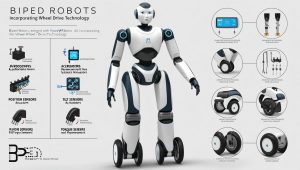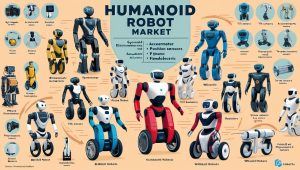The United States humanoid robot market is on the verge of significant expansion, driven by a combination of technological advancements, an increasing need for automation, and the rising demand for human assistance across various sectors. As industries seek to enhance operational efficiency, reduce labor costs, and provide innovative solutions to complex challenges, humanoid robots are emerging as pivotal players in transforming business models and improving the quality of life.

The Rise of Humanoid Robots: A Technological Revolution
Humanoid robots are designed to perform tasks traditionally executed by humans, such as customer service, caregiving, and industrial operations. These robots are engineered to mimic human appearance and behavior, making them ideal for a wide range of applications that require direct interaction with people or handling tasks in human-centric environments.
Recent advancements in artificial intelligence (AI), machine learning, and robotics have been key enablers of this technological evolution. Through these innovations, humanoid robots are now capable of performing increasingly complex tasks autonomously. Their ability to process vast amounts of data, interpret environments, and interact with humans in a meaningful way has allowed them to move beyond simple assistance to more complex problem-solving roles in various industries.
The US humanoid robot market will grow from USD 0.58 billion in 2024 to USD 3.83 billion by 2029, growing at a CAGR of 45.7% from 2024 to 2029.
Key Drivers of Growth in the Humanoid Robot Market
-
Rising Demand for Automation
Automation is rapidly reshaping industries across the United States, with businesses striving to optimize operations, enhance productivity, and minimize operational costs. Humanoid robots, equipped with sophisticated AI algorithms, are being adopted to perform tasks such as warehouse management, production line automation, and assembly operations. These robots improve efficiency and minimize the risk of human error, providing a level of consistency and reliability that human workers alone cannot offer. Additionally, their ability to work around the clock without breaks or fatigue is a major advantage in sectors that demand 24/7 operations, such as logistics and manufacturing. -
Need for Human Assistance in Healthcare and Elderly Care
The healthcare sector is one of the primary areas where humanoid robots are making significant strides. With the rising aging population and the shortage of caregivers, robots are being developed to assist in elderly care and healthcare tasks. Humanoid robots can help monitor patients’ health, provide companionship, and assist with daily tasks, such as medication reminders and mobility assistance. Their ability to interact naturally with patients, offer support, and alleviate human workers’ burdens is making them a valuable tool in the fight against healthcare worker shortages. Moreover, robots like SoftBank’s Pepper have been deployed in hospitals and eldercare centers to engage patients, provide information, and deliver emotional comfort. -
Growing Interest in Robotics in Service Industries
Customer service and retail are other industries where humanoid robots are increasingly deployed. Robots like Pepper, Robothespian, and NAO are becoming familiar faces in stores, hotels, and airports, where they assist with tasks like guiding customers, answering questions, and providing entertainment. In retail, humanoid robots are not only enhancing customer experiences but also providing valuable data and insights into customer behavior. The ability of robots to interact with customers, provide personalized services, and collect data about preferences has opened up new opportunities for businesses to improve their customer service strategies and operational efficiency. -
Innovation in Artificial Intelligence and Machine Learning
AI and machine learning are playing a central role in the evolution of humanoid robots. With these technologies, humanoid robots are becoming increasingly capable of understanding and responding to human emotions, making them more effective in caregiving roles and customer-facing applications. For instance, humanoid robots are now able to analyze facial expressions, recognize voices, and adapt their responses based on the context of the interaction. AI-powered robots can also learn from their experiences, improving their ability to perform tasks and interact with humans over time. This level of adaptability and personalization has made humanoid robots a vital asset for industries looking to enhance customer satisfaction and engagement. -
Supportive Government Policies and Investments
The growth of the humanoid robot market in the United States is also being fueled by government support in the form of research grants, tax incentives, and policy initiatives that encourage innovation in robotics and AI. The National Robotics Initiative (NRI) and other funding programs are providing the necessary capital for developing humanoid robots with enhanced capabilities. As the U.S. government recognizes the potential benefits of humanoid robots in solving labor shortages, increasing efficiency, and improving quality of life, it is expected that further investments will continue to flow into this space, driving market growth.
Download PDF Brochure @
https://www.marketsandmarkets.com/pdfdownloadNew.asp?id=99567653

Challenges and Opportunities Ahead
While the potential for the humanoid robot market is vast, several challenges need to be addressed to ensure its widespread adoption. One of the primary obstacles is the cost of humanoid robots, as the technologies that power them are still expensive to develop and manufacture. However, as mass production increases and technology advances, the cost of humanoid robots is expected to decrease, making them more affordable for businesses and individuals.
Additionally, there are ethical concerns around the use of robots, particularly in areas like caregiving and decision-making. As humanoid robots become more integrated into daily life, ensuring that they are used responsibly and safely will be a key factor in their long-term success.
Nevertheless, the opportunities in the humanoid robot market far outweigh the challenges. With advancements in AI, better cost-efficiency, and broader adoption across various sectors, the future of humanoid robots in the United States looks extremely promising.
A Bright Future for Humanoid Robots
The U.S. humanoid robot market is expected to experience robust growth in the coming years, driven by innovations in technology, an increasing need for automation, and a growing demand for human assistance across industries like healthcare, customer service, and manufacturing. As humanoid robots continue to evolve, they will play an increasingly central role in shaping the future of work and enhancing quality of life.
As businesses and consumers embrace the next generation of AI-powered robots, the United States is likely to remain at the forefront of this technological revolution, paving the way for a future where humanoid robots seamlessly integrate into daily operations and human environments.
